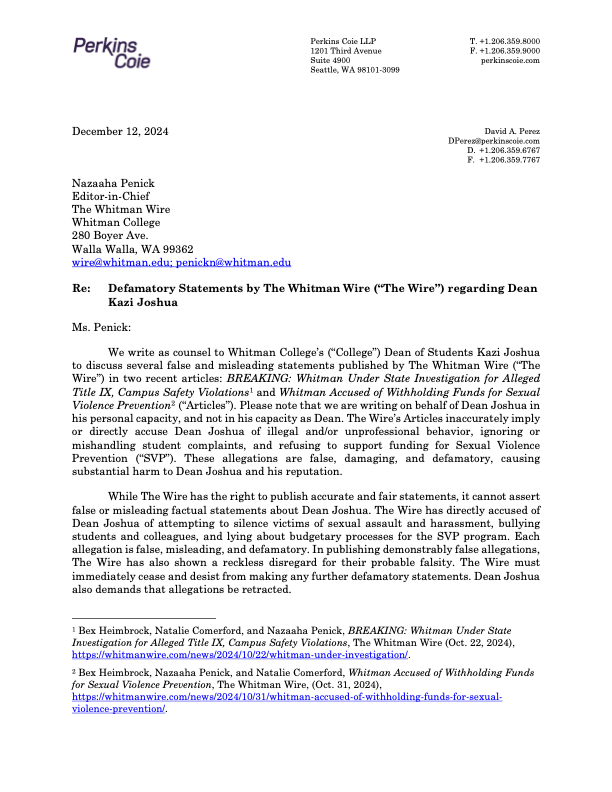The Trail Room at Lewis and Clark College in Portland is in many ways like Café 66 here at Whitman College. It offers pizzas, a grill menu and specialties and, like Whitman’s dining facilities, is run by Bon Appétit Managing Company (BAMCO). But as of this year, the Trail Room is open until midnight. This and other changes stemmed from action by a student committee. While Bon Appétit has common threads at its campuses nationwide, its dining halls, hours and environmental practices vary from school to school.
Whitman has always had decentralized dining halls. According to Whitman Treasurer Peter Harvey, there was a fund-raising effort in the late 1980s to build a central dining hall on campus. The proposal was strongly rejected by both alumni and students and the project failed. No one could bear to part with their dining halls. They are very much a part of Whitman’s identity.
“One of the things I liked about Whitman was the multiple dining halls,” first-year Erik Feldman said. “Each one is different and has its own character.”
Because of this unique set-up, the way Bon Appétit is fashioned here differs from other schools. More dining halls cost more money because they must hire more staff and be open more total hours. This is effectively why the dining halls are only open for only an hour at a time. Making the hours staggered, as well as keeping Café 66 open slightly longer is meant to combat the issue.
The size and layout of the dining halls also prohibit using declining balance, a flex dollar-oriented meal plan which, according to Sam Currie, the BAMCO district manager of the West Coast, is rising in popularity. More schools are using this method of payment because it seems to increase student satisfaction.
Currie explained that the process of deciding how Bon Appétit is run at different facilities can be complicated. As part of his job, he meets with a school to decide how things will work financially, logistically and with the campus atmosphere.
Baseline Bon
“BAMCO is about approaching things from a restaurant standpoint as opposed to a food service one,” said Roger Edens, Whitman’s BAMCO general manager.
This means that each branch has an executive chef in charge of culinary aspects, with a focus on local and seasonal menus.
“There is no such thing as a corporate recipe book with Bon Appétit,” Edens said.
A “from-scratch” style of cooking is essential. There are some food items that aren’t purchased pre-made, such as soups and sauces. This way, it’s “easier to know what’s in things and avoid the bad,” said Susan Todhunter, Resident Dining Manager at Prentiss.
A salad bar is required at all BAMCO dining halls, and they cater to self-serve, all you can eat and à la carte dining. Exhibition cooking, where the food is made in front of customers, as seen in Café 66’s Fire and Spice, is also encouraged.
In addition, BAMCO has several principals and initiatives which are non-negotiable. These are seen on table toppers in every dining hall: trans fat free cooking oils, antibiotic free meat, Monterey Bay Seafood Watch, Low Carbon Diet and the Eat Local Challenge to name a few.
In accordance with their Farm To Fork initiative, all BAMCO services are encouraged to buy as much local produce as they can–which is defined as being grown within 150 miles. Some of the suppliers that Whitman’s Bon Appétit regularly deals with are the Shepard’s Grain farmers’ co-op and Country Natural Beef, both based in the area. Overall, Bon Appétit strives for 20 percent of its food to be local.
“Despite being in the middle of farm country, this is a challenge,” said Edens. “These monoculture farms in the area ship all over, and there isn’t room for local buyers. The local markets are more developed in places like Portland and Seattle.”
Schools like Lewis and Clark and Reed College in Portland, which also uses BAMCO, offer a much higher percentage of local food in and out of season. This is not only because of the amount of local connections; the harvesting season on the coast is longer as well and there is more crop diversity.
One of the things that Bon Appétit does to ensure diverse and quality food is by holding culinary workshops for regional chefs. This past summer, a vegan training took place, put on with the help of Chef Raghavan Iyer, author of “660 Curries.” Currie explained that, “Vegan is creative and encourages better flavor profiles. We want to make vegan taste good.”
Student Influence
“If we weren’t serving students’ needs, we wouldn’t be here,” said Todhunter. “What we serve is driven by student choices, but we also try to educate people about good choices.”
That’s a lot to cover considering the variations in student needs and preferences.
“Bon Appétit does a really amazing job,” said junior Lauren McCullough, the northwest regional field organizer for the Real Food Challenge. “They have to cater to such a wide range. From a meat-and-potatoes person to a militant vegan like me.”
However each school has a different demographic, which significantly drives their menu choices. Many schools are moving towards having more vegan and vegetarian options, based on what students want. However, at College of Idaho in Caldwell, there are very few vegans, thus a less vegan-oriented menu.
Lewis and Clark’s main dining hall, The Bon, has a “big emphasis on vegan,” said Dina Lovenstein, a first-year at Lewis and Clark. “Most of the baked goods are gluten free or vegan, and half of the meal choices are vegan . . . It makes me feel good and study better.”
According to Currie, many students at schools with a more vegan and vegetarian focus choose to eat that way part of the time, even if they don’t classify themselves that way.
For Edens, accommodating students’ needs often lines up with the goals of the company. As of this year, the Celiac-Friendly Zone was added to Prentiss Dining Hall.
“We found that students having issues related to gluten, such as those with Celiac Disease were increasing every year,” said Edens in an e-mail. “Last year Susan Todhunter and I were discussing different ways we could reach out to the student population that were dealing with medical issues, and about the same time Bon Appétit nutritionists were also thinking of ways that individual Bon Appétit colleges could help those with gluten related conditions–hence the Celiac Friendly Zone.”
There are other ways, aside from medical and dietary needs, that students create change in their dining halls.
In the fall of 2008, a student-run petition to get rid of trays in Whitman’s dining halls began. It was pitched as a way to conserve water and reduce waste and cost. After a very positive student survey, the dining halls went completely trayless. The whole process took only about two weeks.
“I wanted to see it happen,” said Edens. “It was a cooperative decision.”
At other schools, it is not as easy. At the Bon Appétit for Carleton College in Northfield, Minn., going trayless is a harder transition. The idea has been advocated since 2008, yet not enacted because they use a conveyor belt system for washing dishes in which the trays are essential.
“Bon Appétit is very helpful, considerate and responsive to student concerns,” said senior Donald Clark, who was involved in the trayless initiative here. “But it is also a business, bottom line.”
That is to say that like other businesses, BAMCO has to protect its interests. Other proposed changes, such as Meat Free Mondays, though never outright rejected because of policy, have been turned down for financial reasons.
“Many expect them to be very confrontational but they aren’t.” Clark said. “I have respect for BAMCO management. They have to navigate a very fine line between sustainability and business.”
BAMCO is constantly updating and changing. Like the new furniture that appeared in Prentiss over mid-semester break or the trayless initiative, changes can happen quickly. However, initiatives such as BAMCO’s push towards more local food is a slower process.
“Quality of food and student satisfaction is vastly improved [from before Bon Appétit],” said Harvey. “They do a great job with variety and mixing it up.”




